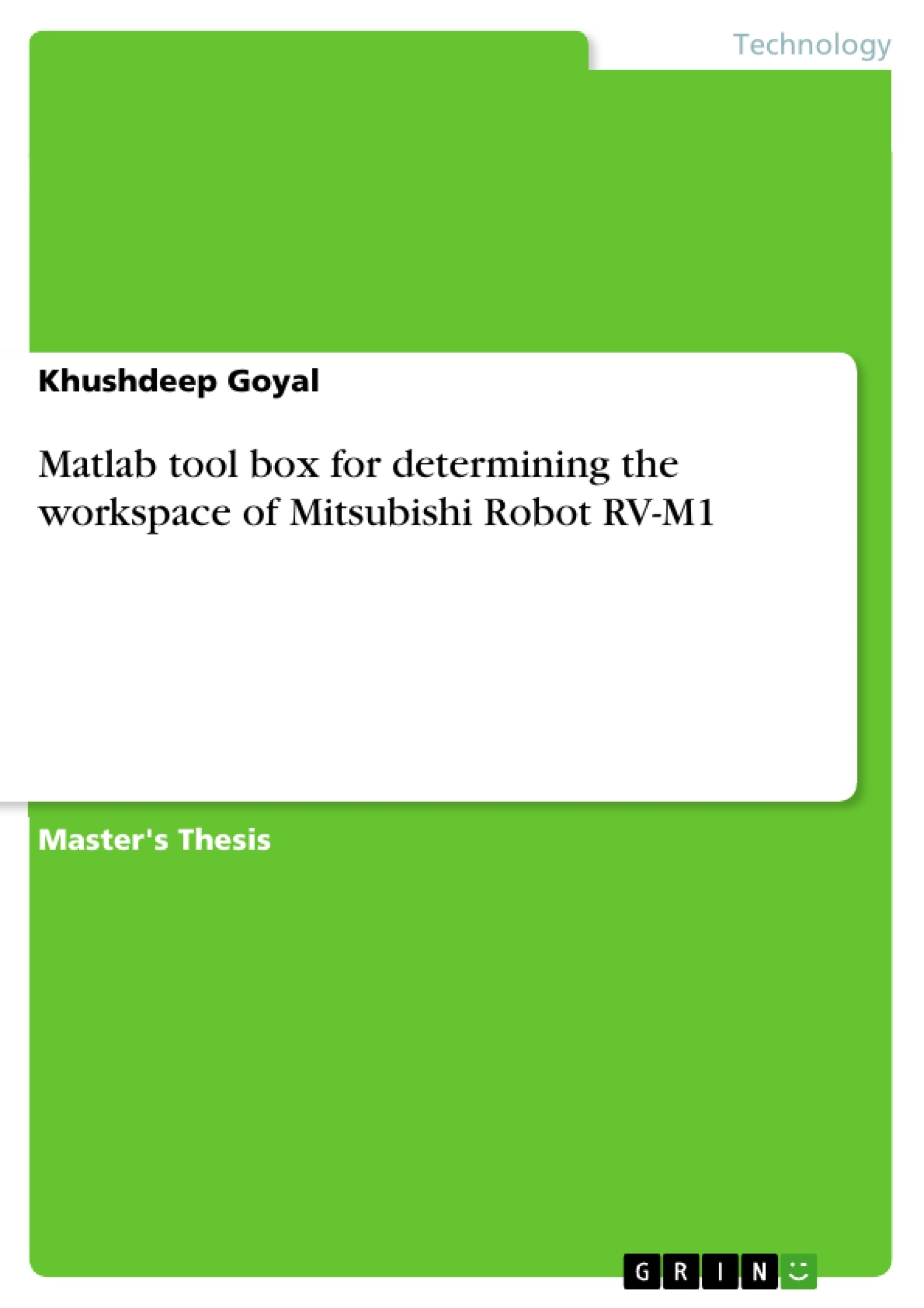The workspace of RV-M1 Mitsubishi Robot is determined by an analytical method.
The method is applicable to kinematic chains that can be modeled using the
Denavit-Hartenberg representation for serial kinematic chains. This method is
based upon analytical criteria for determining singular behavior of the mechanism.
By manipulating the Jacobian of the robot by the row rank deficiency condition, the
singularities are computed. Then these singularities are substituted into the
constraint equations to parameterize singular surfaces. The boundary conditions of
the joints are substituted to obtain the other set of singularities. These singularities
are substituted in the wrist vector to obtain the range of motion of the robot wrist in
three dimensional space, which is the workspace of the Mitsubishi Robot RV-M1.
These singularities are plotted in Matlab to develop all the surfaces enveloping the
workspace of the Robot. The toolbox developed also shows three dimensional
view of the workspace, front view, and top view of the workspace. The utility of the
workspace development is shown through a case study, in which, Robot wrist
range is determined at different heights of Machine bed, for integration of Robot
RV-M1 and VMC Machine. A loading and unloading application of the VMC
Machine by the Robot can be planned using this data. This application is simulated
using the developed toolbox.
Inhaltsverzeichnis (Table of Contents)
- Abstract
- List of Figures
- List of Tables
- Chapter 1: Introduction
- 1.1 Robot Workspace
- 1.2 Motivation and Objectives
- 1.3 Scope and Organization
- Chapter 2: Literature Review
- 2.1 Introduction
- 2.2 Robot Kinematics
- 2.2.1 Joint Types
- 2.2.2 Forward Kinematics
- 2.2.3 Inverse Kinematics
- 2.3 Denavit-Hartenberg (D-H) Representation
- 2.4 Workspace of Robots
- 2.5 Determining the Robot Workspace
- Chapter 3: Mitsubishi RV-M1 Robot Kinematics
- 3.1 Introduction
- 3.2 D-H Parameters for RV-M1
- Chapter 4: Workspace Determination
- 4.1 Introduction
- 4.2 Singularities
- 4.3 Constraint Singularities
- 4.4 Workspace of RV-M1 Robot
- Chapter 5: Workspace Applications
- 5.1 Introduction
- 5.2 Simulation of Workspace
- 5.3 Integration of VMC Machine with RV-M1 Robot
Zielsetzung und Themenschwerpunkte (Objectives and Key Themes)
This master's thesis focuses on developing an analytical method for determining the workspace of the Mitsubishi RV-M1 robot. The primary objective is to create a MATLAB toolbox that accurately calculates and visualizes the robot's workspace using the Denavit-Hartenberg representation and singularity analysis. The key themes explored in the thesis include:- Robot kinematics and workspace analysis
- Denavit-Hartenberg representation for serial kinematic chains
- Singularity analysis and its application to workspace determination
- MATLAB implementation for workspace visualization and simulation
- Integration of the robot with a Vertical Machining Center (VMC) machine
Zusammenfassung der Kapitel (Chapter Summaries)
- Chapter 1 provides an introduction to the concept of robot workspace and outlines the motivation, objectives, and scope of the thesis. It highlights the importance of understanding the workspace for robot integration and task planning.
- Chapter 2 reviews relevant literature on robot kinematics, the Denavit-Hartenberg representation, and various methods for determining robot workspace. This chapter lays the theoretical foundation for the thesis.
- Chapter 3 focuses on the specific kinematics of the Mitsubishi RV-M1 robot. It establishes the Denavit-Hartenberg parameters for the robot's joint structure and provides a detailed kinematic analysis.
- Chapter 4 presents the analytical method for determining the workspace of the RV-M1 robot. This chapter focuses on identifying and characterizing the singularities of the robot's motion, which are used to define the boundaries of its workspace.
- Chapter 5 explores various applications of the developed workspace determination method. It includes simulations using the MATLAB toolbox and showcases the integration of the robot with a VMC machine.
Schlüsselwörter (Keywords)
The primary focus of this work is on robot workspace determination, using the Denavit-Hartenberg representation, singularity analysis, and MATLAB implementation. Key terms include: robot kinematics, Denavit-Hartenberg parameters, workspace, singularities, constraint equations, Mitsubishi RV-M1 robot, MATLAB toolbox, VMC integration, task planning.- Citar trabajo
- Khushdeep Goyal (Autor), 2002, Matlab tool box for determining the workspace of Mitsubishi Robot RV-M1, Múnich, GRIN Verlag, https://www.grin.com/document/147218



